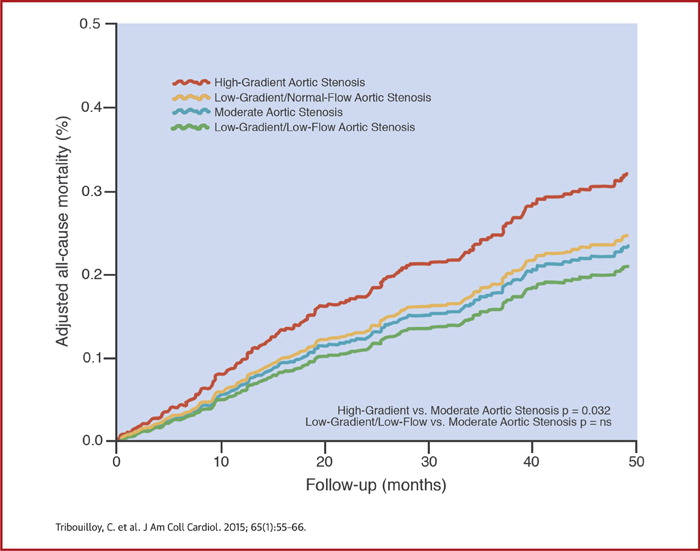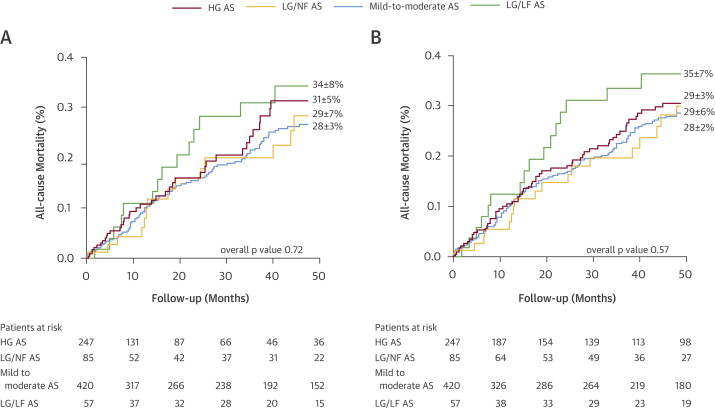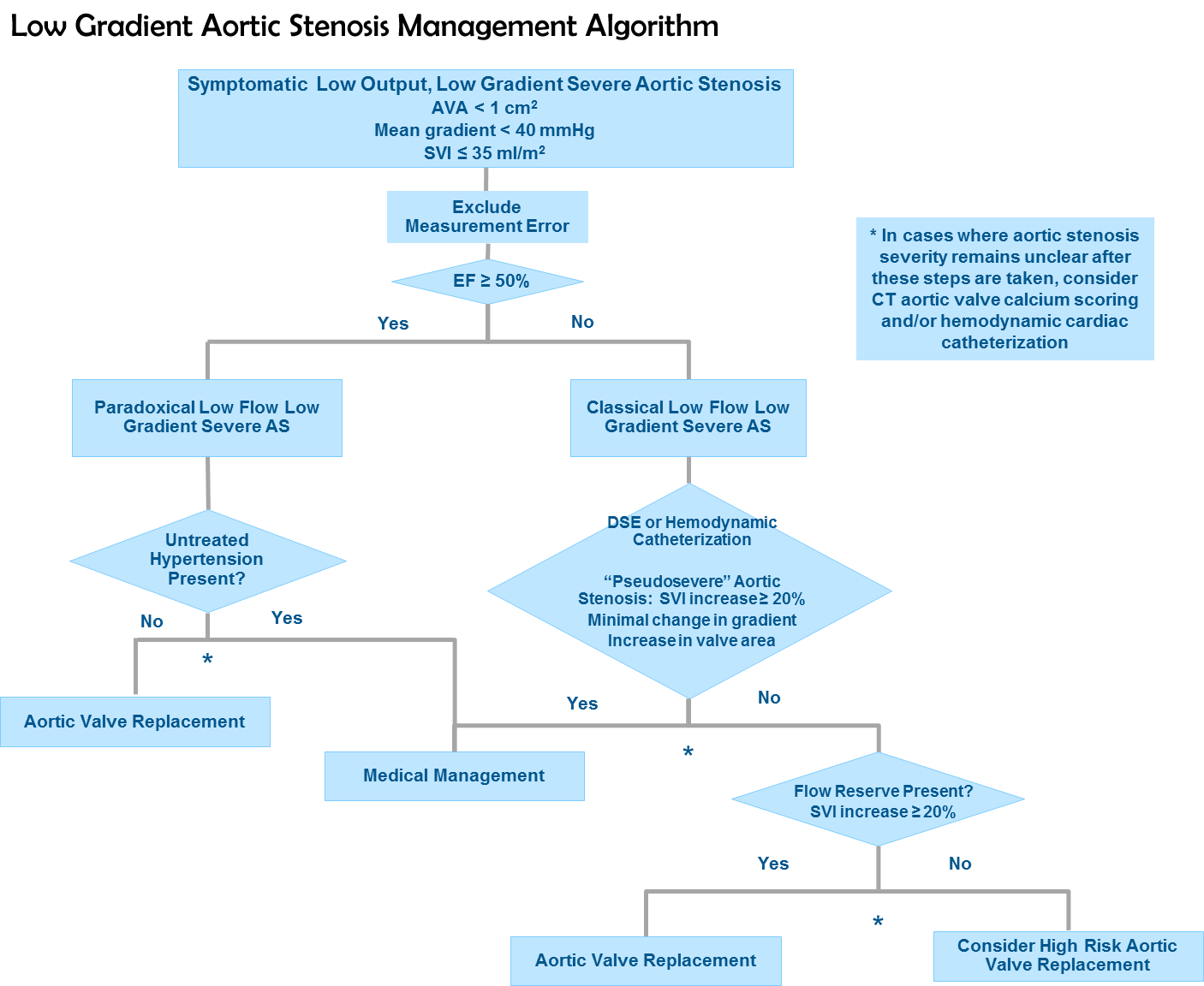Low Gradient Severe Aortic Stenosis with Preserved Ejection Fraction: A Comprehensive Approach to the Individual Patient with Symptoms is Key
Background
There remains debate about the outcome and management of low-flow (LF) low-gradient (LG) aortic stenosis (AS) patients with preserved ejection fraction (EF) and symptoms.
Methods
The authors performed a retrospective analysis of 809 patients with both moderate (n=420) and severe AS (LF/LG = 57, normal flow (NF) LG = 85, high-gradient (HG) = 247) after excluding patients that underwent AVR in the first 3 months after echocardiogram.
Results
Adjusted survival analysis showed overall mortality risk of LF/LG was similar to moderate AS (adjusted HR 0.96, 95% CI: 0.58-1.53).
Conclusions
From the authors' abstract: "the outcome of severe LG/LF AS with preserved EF was similar to that of mild-to-moderate AS and was not favorably influenced by aortic surgery."
The study by Tribouilloy et al. of a large group of patients with AS at two centers found that LG patients with both NF and LF seemed to have similar survival as moderate AS patients1. The heterogeneous nature of LG severe AS patients makes it a challenging group to study, given the multiple patient factors (atrial fibrillation, left ventricular function, concomitant valvular lesions, hypertension, body size), and echocardiographic measurements that contribute to both LF and LG. Differences in prevalence of symptoms, severity of symptoms and nature of the clinical practice (large referral center, community hospital, etc.) also impact upon the overall prognosis and referral rate for AVR in a specific AS population.
|
The 2014 American College of Cardiology (ACC)/American Heart Association (AHA) guidelines2 classified the "paradoxical" LF/LG entity as a D3 stage of AS, defined as an AVA of <1.0 cm2, an indexed AVA of <0.6 cm2/m2, a mean gradient of <40 mm Hg, a left ventricular EF of >50%, and a stroke volume index (SVi) of <35 ml/m2. The ACC/AHA guidelines recommend aortic valve replacement (AVR) as a Class IIa (Level of Evidence: C) recommendation in D3 AS patients: "AVR is reasonable in symptomatic patients who have low-flow, low-gradient severe AS who are normotensive and have a LVEF ≥50% if clinical, hemodynamic, and anatomic data support valve obstruction as the most likely cause of symptoms."
The article by Tribouilloy et al. at first appears to present conflicting evidence to multiple recent observational cohort studies that demonstrated the LF/LG pattern was associated with significantly increased mortality and a protective effect of AVR in this group3-13. The conclusion of the authors that, "the outcome of severe LG/LF AS with preserved EF was similar to that of mild-moderate AS and was not favorably influenced by aortic surgery" was based upon survival analysis adjusted for multiple covariates. However, it is important to note that adjusted survival curves are theoretical curves and do not reflect outcomes of individual patients and therefore may not be as clinically relevant as crude survival/univariate models. Although the survival analysis adjusted for multiple variables that can contribute to low flow (including ejection fraction, atrial fibrillation and coronary artery disease) (Figure 1) showed no difference in mortality between LF/LG AS and moderate AS, the unadjusted survival curves shown in Figure 2 suggest that LF/LG AS is associated with a higher mortality compared to the other groups (four-year mortality estimate 35 ± 7% vs. 28-29% in the other groups). These survival estimates are in accordance with survival estimates shown in multiple previous investigations of these flow-gradient groups3-13. Additionally, in the overall population with severe AS in this paper, a strong survival benefit of AVR was demonstrated (HR 0.49; 95% CI 0.35-0.68). Importantly, very few patients in the LF/LG group (< 10%) underwent AVR in this study, which limits statistical power and conclusions that can be drawn about the effect of AVR in this subgroup.
There remains intense debate as to whether LF/LG is a more advanced form of AS and how best to treat such patients1,16. The real question, however is not whether LF/LG represents a more "advanced form" of AS in terms of degree of valvular obstruction, since multiple recent imaging studies have shown it to be a distinct entity with a unique left ventricular remodeling pathway without preceding HG AS, but rather less intrinsic valve calcification and obstruction17-18. The more important question is how best to manage these patients and whether they derive benefit from aortic valve replacement (AVR). It is clear that LF/LG patients have a higher prevalence of comorbidities, including atrial fibrillation, reduced arterial compliance, previous heart failure episodes and more abnormalities of left ventricular function despite having an EF > 50%, which may leave them more vulnerable to the added afterload imposed by AS compared to the general AS population.
In clinical practice, the symptomatic patient with LG severe AS and preserved ejection fraction presents a challenge of confirming the severity of AS and excluding other causes of symptoms using a combination of careful history-taking, physical examination, rigorous 2-D and Doppler assessment, and integration of other modalities including aortic valve CT calcium scoring and invasive cardiac catheterization when necessary. When untreated hypertension is present, the hypertension should first be treated followed by re-assessment AS severity and symptoms19. This manuscript raises questions as to whether symptomatic confirmed D3 AS patients should be offered AVR; these questions will only be definitively answered by future studies of larger numbers of patients and randomized trials.
References
- Tribouilloy C, Rusinaru D, Maréchaux S, et al. Low-gradient, low-flow severe aortic stenosis with preserved left ventricular ejection fraction: char- acteristics, outcome, and implications for surgery. J Am Coll Cardiol 2015;65:55–66.
- Nishimura RA, Otto CM, Bonow RO, et al., ACC/ AHA Task Force Members. 2014 AHA/ACC guide- line for the management of patients with valvular heart disease: a report of the American College of Cardiology/American Heart Association Task Force on Practice Guidelines. Circulation 2014;129: e521–643.
- Hachicha Z, Dumesnil JG, Bogaty P, et al. Paradoxical low-flow, low-gradient severe aortic stenosis despite preserved ejection fraction is associated with higher afterload and reduced survival. Circulation 2007;115: 2856–64.
- Pai RG, Varadarajan P, Razzouk A. Survival benefit of aortic valve replacement in patients with severe aortic stenosis with low ejection fraction and low gradient with normal ejection fraction. Ann Thorac Surg 2008;86:1781–9.
- Belkin RN, Khalique O, Aronow WS, et al. Outcomes and survival with aortic valve replacement compared with medical therapy in patients with low-, moderate-, and severe-gradient severe aortic stenosis and normal left ventricular ejection fraction. Echocardiography 2011;28:378–87.
- Tarantini G, Covolo E, Razzolini R, et al. Valve replacement for severe aortic stenosis with low transvalvular gradient and left ventricular ejection fraction exceeding 0.50. Ann Thorac Surg 2011;91: 1808–15.
- Clavel MA, Dumesnil JG, Capoulade R, et al. Outcome of patients with aortic stenosis, small valve area, and low-flow, low-gradient despite preserved left ventricular ejection fraction. J Am Coll Cardiol 2012;60:1259–67.
- Lancellotti P, Magne J, Donal E, et al. Clinical outcome in asymptomatic severe aortic stenosis. Insights from the new proposed aortic stenosis grading classification. J Am Coll Cardiol 2012;59: 235–43.
- Ozkan A, Hachamovitch R, Kapadia SR, et al. Impact of aortic valve replacement on outcome of symptomatic patients with severe aortic stenosis with low gradient and preserved left ventricular ejection fraction. Circulation 2013; 128:622–31.
- Mehrotra P, Jansen K, Flynn AW, et al. Differential left ventricular remodelling and longitudinal function distinguishes low flow from normal-flow preserved ejection fraction low-gradient severe aortic stenosis. Eur Heart J 2013;34:1906–14.
- Mohty D, Magne J, Deltreuil M, et al. Outcome and impact of surgery in paradoxical low-flow, low-gradient severe aortic stenosis and preserved left ventricular ejection fraction: a cardiac catheterization study. Heart 2015 (in press).
- Eleid MF, Sorajja P, Michelena HI, et al. Flow- gradient patterns in severe aortic stenosis with preserved ejection fraction: clinical characteristics and predictors of survival. Circulation 2013;128: 1781–9.
- Eleid MF, Sorajja P, Michelena HI, et al. Survival by stroke volume index in patients with low-gradient normal EF severe aortic stenosis. Heart 2015 101:23-9.
- Jander N, Minners J, Holme I, et al. Outcome of patients with low-gradient "severe" aortic stenosis and preserved ejection fraction. Circulation 2011;123:887–95.
- Maes F, Boulif J, Pierard S, et al. Natural history of paradoxical low-gradient "severe" aortic stenosis. Circ Cardiovasc Img 2014;7:714–22.
- Dahl JS, Eleid MF, Pislaru SV, et al. Development of paradoxical low-flow, low-gradient severe aortic stenosis. Heart. 2015 (in press).
- Eleid MF, Nishimura RA, Sorajja P, Borlaug BA. Systemic hypertension in low gradient aortic stenosis with preserved ejection fraction. Circulation. 2013; 128:1349-53.
Keywords: American Heart Association, Aortic Valve, Aortic Valve Stenosis, Atrial Fibrillation, Body Size, Cardiac Catheterization, Cohort Studies, Comorbidity, Coronary Artery Disease, Echocardiography, Heart Failure, Heart Valve Prosthesis, Hospitals, Community, Humans, Hypertension, Physical Examination, Prevalence, Prognosis, Referral and Consultation, Retrospective Studies, Stroke Volume, Survival Analysis, United States, Ventricular Remodeling, Ventricular Function, Left
< Back to Listings



